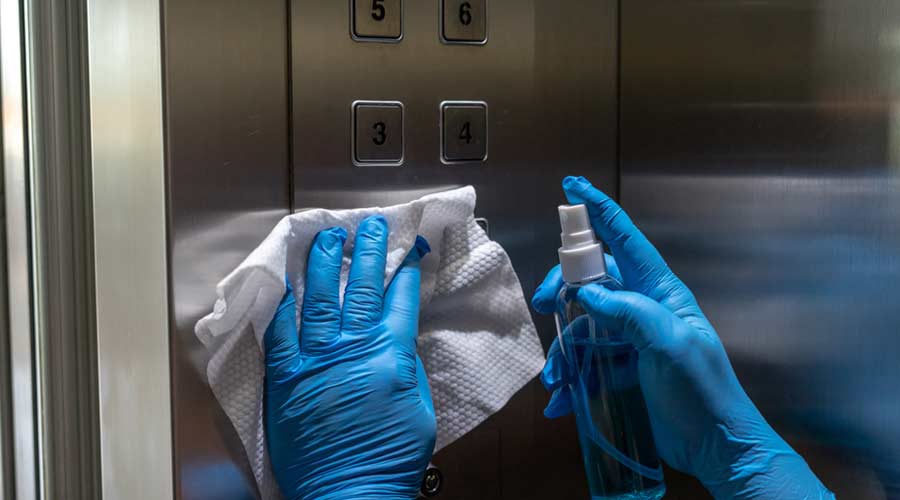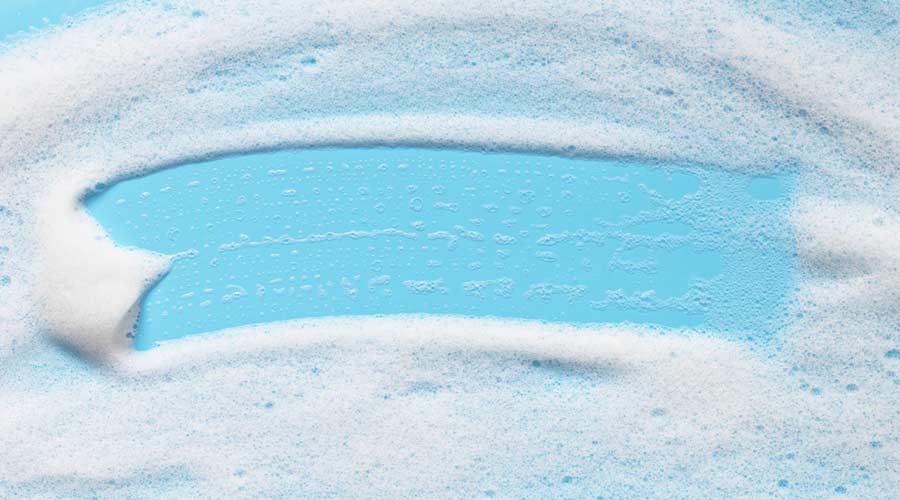
By Sean Schlake, Director, Operational Support Team, at 4M Building Solutions
Green cleaning and sustainability practices in the commercial cleaning industry were first introduced more than two decades ago. Since then, these practices have evolved and gained momentum, saving money in chemical costs, energy and water resources while also protecting health and the environment.
Still, many building operators have not yet embraced green products and practices in their cleaning operations. There may be a perception that they are more costly or perhaps don’t have the cleaning and disinfection power that harsher chemicals offer. While eco-friendly products can cost 10-25 percent more than traditional ones, the cost gap narrows because they are highly concentrated, so less product is needed per cleaning.
Other values that can offset the cost include fewer health issues and lower absenteeism due to allergens and sensitivities, less damage to surfaces and finishes, and support for LEED and sustainability goals to boost reputation or lease value. When considering health, safety, employee satisfaction, product efficiency, and compliance, sustainability investments often result in a better long-term return on investment for the customer.
As for cleaning efficacy, many green cleaning products offer powerful disinfection and cleaning capabilities. They are proven to eliminate a wide range of pathogens effectively—while also meeting safety and environmental standards. The U.S. Environmental Protection Agency’s Design for the Environment program identifies products that are both effective and environmentally friendly.
Building service contractors (BSCs) who can showcase their knowledge and expertise in sustainable solutions in cleaning set themselves apart from their competitors. By touting the benefits of green cleaning and dispelling misinformation about costs or performance, BSCs will have a competitive advantage when it comes to contract renewals and earning new accounts.
This article provides an overview of the major areas where commercial cleaning companies can make the switch to green products and adopt sustainable practices.
The time is right for building operators to make the switch. A Harvard Business Review study says that consumer sustainability demands are rising and “we’re fast approaching a tipping point where sustainability will be considered a baseline requirement for purchase.” A McKinsey-NielsenIQ report shows more than 60 percent of consumers will pay more for a product with sustainable packaging, and 78 percent say a sustainable lifestyle is important to them. Consumers bring this same mindset to their workplaces, with expectations that their employers practice sustainability.
Another selling point BSCs can make: today’s biodegradable, non-toxic cleaners are safer not only for building occupants but also the people who clean the facilities. As society increasingly demands sustainability in the products we buy, commercial cleaning companies can play a role in encouraging facility managers and building operators to incorporate green products into the work, school and health facilities in which we spend so much of our time.
Products and Protocols for Green Cleaning and Sustainability
Cleaning Products
Numerous products are available to help commercial cleaners achieve green cleaning standards:
-
Green Seal and ECOLOGO certifications ensure adherence to strict environmental standards for non-toxic chemicals. Green Seal’s independent third-party certification is recognized globally as a gold standard for protecting people and planet.
-
GREENGUARD and Environment Choice-certified chemicals and equipment ensure that a product’s entire lifecycle meets stringent scientific criteria.
-
Ready-to-dispense (RTD) chemical systems reduce chemical usage by delivering accurate, pre-measured, portable dispensing in 100 percent recyclable containers.
Water Conservation
Water resources are becoming a serious issue in some parts of the United States. Commercial cleaning staff can play an important role in reducing water usage; conservation is important even in areas with plentiful water; less water usage means decreased energy required to treat and deliver water.
-
Most water consumption in a commercial setting will come from fixtures in the restrooms. Old or leaking fixtures can lead to increased water consumption, and cleaning staff can assist by alerting building and facility managers of the leaks in a timely manner. Cleaning staff are often the first to recognize issues and therefore must be trained to raise a red flag.
-
Microfiber flat mops and microfiber cloths require minimal to no water at all for cleaning, and are very effective.
Waste Reduction and Removal
Sustainable waste management seeks to conserve and protect our natural resources through systemic, achievable business practices. This affects not only how items are treated at the ‘end’ of their life cycle, but how they are produced as well.
Over 4.5 billion pounds of janitorial paper consumed annually — equal to more than 30 million trees — are still largely made from virgin tree fiber, according to a widely cited 2002 report by the Alliance for Environmental Innovation. While newer data is lacking and it’s not unreasonable to assume figures have shifted, the core environmental and health concerns of virgin fiber production remain relevant: the required, intensive pulping and bleaching processes consume large amounts of water and energy and release harmful byproducts.
-
The use of recycled-content paper towels and toilet paper is an important practice that is easy to implement. Advancements in recycling have made recycled products at parity with virgin fiber and, in most instances, quality differences are indistinguishable.
-
Many organizations have adopted a ‘single stream’ recycling program that combines all paper, plastics, and metals into one bin. BSCs can assume the program manager role, ensuring recycling programs are adhered to and non-recyclable waste is reduced.
Technology and Equipment
As technology continues to evolve, cleaning companies must evolve as well to create a more sustainable environment. We sometimes think of technology solely as equipment that uses less energy or less water to conserve resources, but it can also include improving indoor air quality and extending the life of flooring and surfaces.
-
Green Seal-certified equipment such as 4X HEPA Filtration for vacuum cleaners captures dust particulates and allergens down to .3 microns. The filtration improves the indoor air quality, positively impacting the building occupants.
-
Battery-operated backpack and wide area vacuums remove more carpet-damaging soils than an upright vacuum with a beater bar. As a result, any carpet will have an increased life span.
-
Commercial cleaning companies should be exploring robotics and AI now, as these technologies play a significant role in advancing sustainability and green cleaning by increasing efficiency, reducing energy and water usage, and minimizing waste. They also enable precise cleaning that lowers emissions.
BSCs can tap into numerous solutions to reduce energy costs for their clients:
-
Day cleaning saves up to 8 percent on utility costs, according to BOMA International’s Building Energy Efficiency Program. When crews operate by the ambient light provided by the sun, ideally between the hours of 6 a.m. and 5 p.m., buildings can be darkened at night, and HVAC can be turned down.
-
Battery-operated backpack, wide area, and ride-on vacuums reduce energy costs as they allow workers to clean faster, reducing the time the vacuum is running.
-
Backpack vacuums have additional energy benefits including lower power requirements and the ability to clean 10,000-15,000 square feet per hour versus 2,000-3,000 for upright or canister vacuums. Also, most commercial buildings do not have electrical outlets in stairwells, making corded vacuuming inefficient. Battery-powered backpack vacuums can tackle stairways at least three times faster.
Sustainability Goals
Commercial cleaning companies can be a valuable partner in assisting clients who are working to meet specific sustainability goals and want to be reassured that their goals are supported. This often includes meeting healthy building certification from the International Well Building Institute, or LEED (Leadership in Energy and Environmental Design), a globally recognized rating system for green buildings. BSCs can contribute to LEED scoring by improving indoor air quality, reducing chemical exposure, and aligning with sustainable operations. This includes using certified green products and adopting eco-friendly purchasing practices for both consumables and equipment.
Lean engineering and other waste eliminating processes offer another opportunity to stand apart from other BSCs by targeting inefficiencies — any activity, process, or product that fails to add value. By leveraging these approaches, organizations can streamline operations, improve productivity, pay higher wages, and reduce costs for clients.
For example, a lean engineering approach can create “timings” that identify when a team will enter a section of a building or facility and when the team will exit. This allows automatic setbacks on HVAC and lighting, reducing the energy consumption in non-occupied areas.
Sustainability is the Future
We live in an increasingly eco-conscious society. As news reports of global environmental issues become more prevalent, the public has higher expectations for the corporate sector to deliver sustainable solutions. Green cleaning products have been embraced by consumers and many industries, and it’s just a matter of time before sustainability will become fully mainstream. BSCs can better service their customers today by adding green/sustainability programs to their existing offerings. This will result in better indoor air quality and better health for the planet as well as more opportunities for commercial cleaning businesses.
Sean Schlake is Director, Operational Support Team, at 4M Building Solutions, and is Lean Six Sigma Yellow Belt certified. A leading commercial cleaning provider, 4M was established in 1978 and now operates in 27 states with 7,000 Team Members. Tim Murch, CEO and Managing Partner of 4M, was on the initial stakeholder committee that developed the standard for GreenSeal Certified cleaning.
posted on 6/18/2025

 The Down and Dirty on Cleaning in Virus Season
The Down and Dirty on Cleaning in Virus Season How Surfactant Use is Expanding in Commercial Cleaning
How Surfactant Use is Expanding in Commercial Cleaning